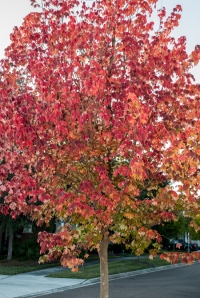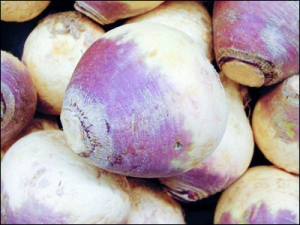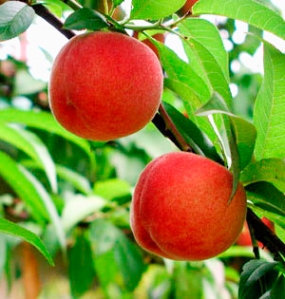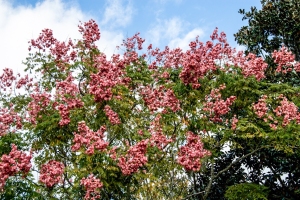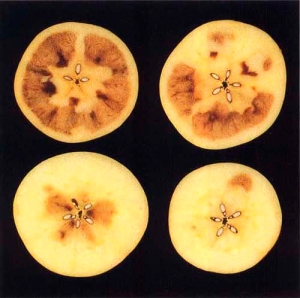A: No, the two maples are different species. The red maple is Acer rubrum while the Trident maple is Acer buergeranum. Notice the first name, which is the genus, is the same as this identifies all maples. However, the last name, which identifies the species, is quite different. They are both deciduous, tolerate occasional dampness and grow well in this area. The leaves of the Trident maple are distinct as they have only three lobes whereas the red maple has multiple lobes. Trident maples can grow to about 45-feet tall with about a 25 foot spread. The leaves are glossy green above and paler underneath, which turn various shades of red, orange, and yellow in autumn. Flowers are bright yellow and showy in the spring. Typically Trident maples are found multi-stemmed but they can be trained to have only one central trunk. Red maples are fast growing whereas Trident maples grow at a moderate rate. In addition, the bark of the Trident maple is orange-brown which adds winter interest once all the leaves drop. Trident maples make good patio specimens if space is limited and are often used as bonsai plants. Trident maple should be planted in full sun or partial shade on any well-drained, acid soil and is quite tolerant of salt, air pollution, wind, and drought. Like other maples, some chlorosis can develop in soils with pH over 7 but it is moderately tolerant of soil salt. It performs well in urban areas where soils are often poor and compacted. Trees are easily transplanted due to their shallow root system and are fairly ‘clean’ trees since they do not drop messy leaves, fruit or flowers. Several cultivars are known, with trees having dwarf growth, corky bark, variegated leaves, and a variety of leaf shapes. Some particularly good cultivars include: ‘Akebono’, ‘Goshiki Kaede’, ‘Maruba’, and ‘Mino Yatsubusa’. They have not been tested extensively in urban areas and will probably be difficult to find. For more information please check out the University of Florida publication: http://edis.ifas.ufl.edu/st009
Monthly Archives: November 2014
Q: When do I harvest rutabaga? I am concerned about the cold temperatures coming and did not want it to get destroyed before I get a chance to eat it.
A: Rutabaga is a cool season vegetable, which means it grows best in the winter in Florida. Rutabaga will withstand frosts and mildly freezing temperatures so there should be no problem for the next few days. For the most part, it is found primarily in home gardens here in Florida with no large commercial growers currently producing it. Rutabagas require a longer growing season (about 90 days) than do turnips so expect to harvest them 3 months after planting. Rutabagas are often confused with turnips but turnip leaves are light green, thin, and hairy whereas rutabaga leaves are bluish green and smooth like cabbage. The leaves of rutabaga are edible but I’ve been told they are not pleasant. The flesh of turnips is white but rutabaga flesh has a yellow tint. Turnips have no neck or elongated area where the leaves attach to the root. Rutabagas have a slightly elongated neck area. If you grow rutabagas from seed be sure to space them 3-4 inches apart in 30-inch rows. The main varieties are ‘American Purple Top,’ ‘Macomber,’ ‘Purple Top Yellow’, ‘Long Island Improved,’ ‘Sweet Russian,’ ‘Laurential,’ and ‘Zwaan’s Neckless Purple Top.’ http://edis.ifas.ufl.edu/pdffiles/MV/MV12700.pdf
Q: Some of my oak tree leaves are dropping and they have little small growths on them. What are they?
A: I have received several calls on this and I am glad you brought in a sample for me identify. Oak leaf blister is a common leaf disease among oaks in Florida and is caused by fungus. Although infected trees may have unsightly leaves, serious damage is uncommon. The fungus which causes leaf blister attacks only the leaves, and does no damage to other parts of the tree. Spores of the pathogen infect young oak leaves. As the pathogen develops within the leaf, it causes a disruption of normal development of leaf cells. The infected tissues appear swollen or blister-like and lighter in color. Severe infections can cause the leaf to become curled or twisted. Over time the infected tissues die, leaving gray-brown areas scattered within the given leaf. Leaf blisters first appear on the underside of leaves as small, slightly depressed gray areas. Over time the infection causes the leaf to become deformed, forming a blister. The blisters can grow to be 1/3″ or larger and can be seen on both sides of the leaf. There may be several blisters on a leaf and if blisters occur near the edge, leaf curl may result. Oak leaf blister is not usually noticed until many leaves have become much blistered or excessive leaf fall occurs. Any oak can be infected; however live oak, water oaks, and laurel oak are preferred hosts. Oak leaf blister was especially prevalent last season because of early spring rainy weather favorable for disease development. The fungus which causes the disease infects young leaves as they emerge, and the distinctive symptoms of oak leaf blister appear several weeks later.
Q: My peach tree is looking anemic. What could be wrong?
A: I am glad you brought in a soil sample so we could test the soil pH for you. We discovered your particular soil was alkaline (over 7.0). Most of our fruit and vegetables prefer a slightly acid soil which is between 6.0 and 6.5. When the soil becomes alkaline, often there are limitations to the absorption availability of some nutrients through the roots of the tree. Iron is one of those nutrients. It is involved in the manufacturing process of chlorophyll (the green pigment in leaves), which is important in carbohydrate production and it is required for certain enzyme functions. In high alkaline soils, iron is often unavailable to the plant which is why plants will often develop yellow leaves or look anemic. The University of Florida recommends adding chelated iron to the root area of the fruit tree when soils are above 7.0. Chelated iron is basically a type of iron with a special coating on it which will make it more available to the plant when the soil is alkaline. Many of our areas, especially along the coastal parts of Nassau, will have high alkaline soils. Fruit trees, such as your peach tree, could benefit from incorporating chelated iron into the soil around the roots. The directions on the package of chelated iron will provide the appropriate amount to apply. Please follow the directions on the package as too much chelated iron can cause other problems. Remember, you can always use less than the label recommendations but NEVER more. The “Label is the Law.”
Q: What is the name of the tree with the salmon colored seed pods? It is so pretty, I just love it.
A: While it is true that this tree is beautiful it is also considered a pest tree. Golden rain tree, Koelreuteria elegans, is native of Taiwan and it has become a very popular landscape tree because of its colorful yellow petals and rose colored fruit capsules. Even though this tree is loved and valued by many, we cannot ignore the invasive characteristics which initiated its appointment as a Category II exotic invasive. Koelreuteria is a fast growing plant able to grow in an array of environmental conditions. Golden rain tree seeds are thought to be spread by birds and have the capability of germinating as quickly as 6-8 days. It is a deciduous tree that grows 25 to 50 feet in height, with a 35 to 50 foot diameter spread. Introductions of Koelreuteria as an ornamental tree have made it possible for this tree to escape from cultivation and naturalize in Texas, Louisiana, Alabama, and Florida. Because it is a fast grower and has greater seed viability in warmer climates, Golden rain tree has the ability to crowd out desired native species which means it can and does completely alter the local landscape. It is best for us to refrain from purchasing, propagating, or planting Golden rain tree due to its ability to escape into natural areas.
Q: I bit into an apple and a large portion of the area around the core was mushy and brown. It looked perfect on the outside. What would cause this?
A: I was able to locate two universities (Washington State and University of California) which have conducted studies of various types of apples. Both universities have discovered the potential cause most likely occurs after harvesting of the apples. I am sure there are other universities conducting the same research, but these two directly addressed the internal discoloring of the flesh around the core of the apple. The internal browning of apples during postharvest storage varies from year to year, but there is strong evidence pointing to how early the apples are harvested and the carbon dioxide concentration in storage atmospheres. The occurrence of internal browning was reduced when the apples were harvested within 180 days after bloom. If left on the tree longer, the potential for internal browning increased. In addition to harvesting at the appropriate time the apples needed to be stored where the concentration of CO2 was at levels below 0.5% to reduce losses from the internal browning disorder. The good news is the cause is not a pathogen such as a fungi, virus or bacteria and in most instances this problem can be avoided by proper harvesting and storage procedures. Unfortunately, you and I cannot detect this problem simply by looking at the external part of the apple – it is just the luck of the draw.

